Analysis of Business Law and Ethics
VerifiedAdded on 2020/10/05
|14
|5178
|394
AI Summary
The assignment provided is an in-depth analysis of business law and ethics, which involves researching and discussing various topics related to the subject. The student needs to read and understand multiple references from books, journals, and online sources, including articles and websites. The assignments also mentions that there are different dispute resolving options available to organisations, and it seems that there is a need for a comprehensive analysis of business law and ethics in the modern business environment.
Contribute Materials
Your contribution can guide someone’s learning journey. Share your
documents today.
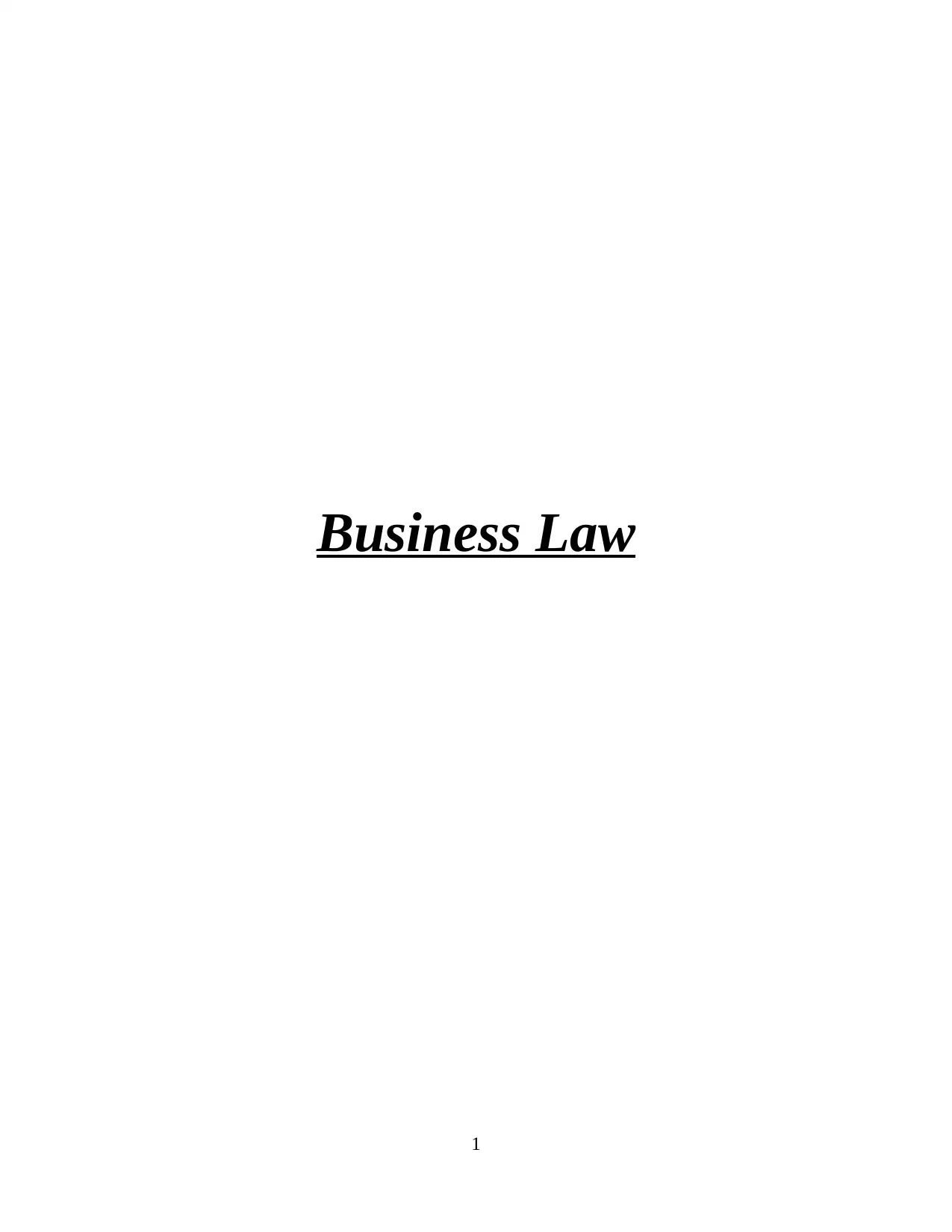
Business Law
1
1
Secure Best Marks with AI Grader
Need help grading? Try our AI Grader for instant feedback on your assignments.
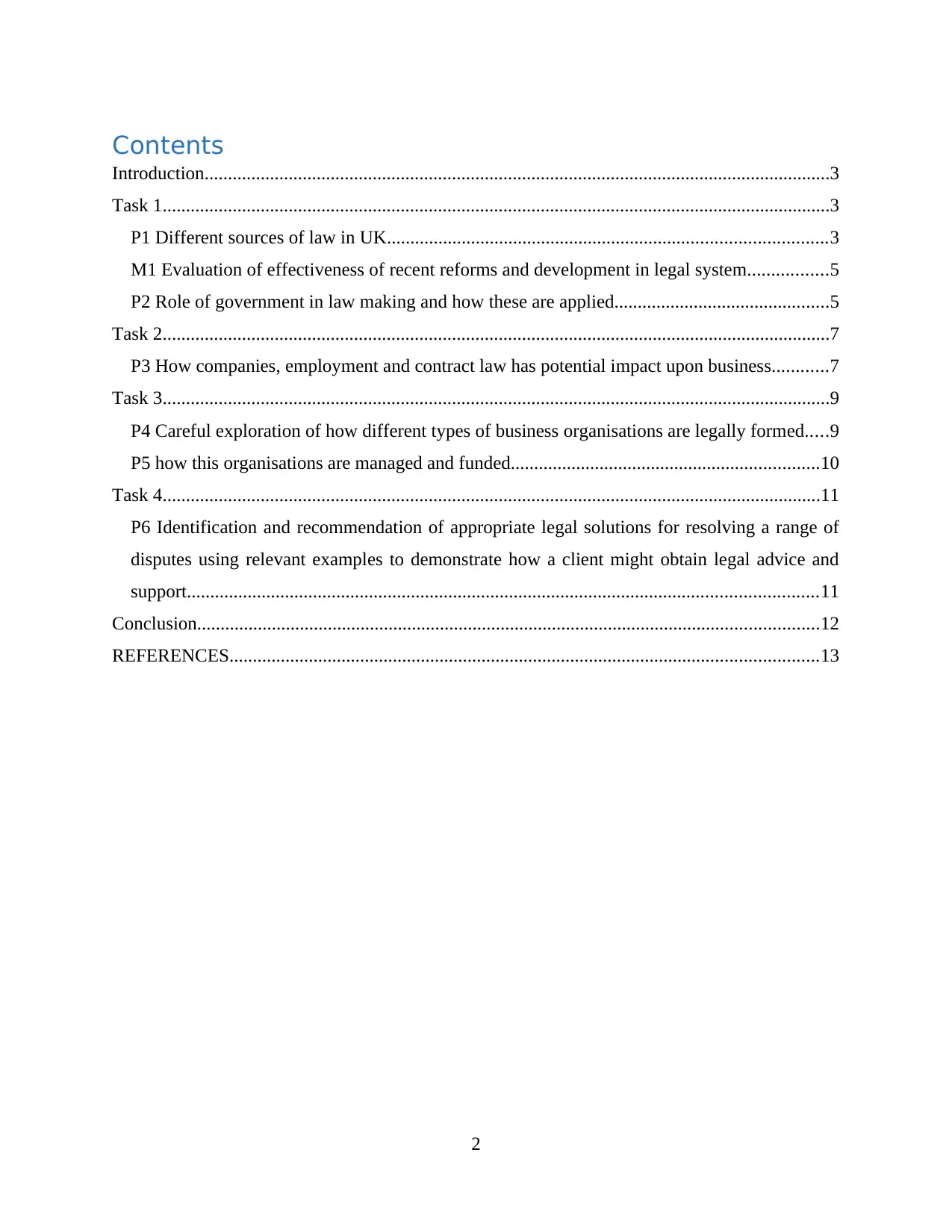
Contents
Introduction......................................................................................................................................3
Task 1...............................................................................................................................................3
P1 Different sources of law in UK..............................................................................................3
M1 Evaluation of effectiveness of recent reforms and development in legal system.................5
P2 Role of government in law making and how these are applied..............................................5
Task 2...............................................................................................................................................7
P3 How companies, employment and contract law has potential impact upon business............7
Task 3...............................................................................................................................................9
P4 Careful exploration of how different types of business organisations are legally formed.....9
P5 how this organisations are managed and funded..................................................................10
Task 4.............................................................................................................................................11
P6 Identification and recommendation of appropriate legal solutions for resolving a range of
disputes using relevant examples to demonstrate how a client might obtain legal advice and
support.......................................................................................................................................11
Conclusion.....................................................................................................................................12
REFERENCES..............................................................................................................................13
2
Introduction......................................................................................................................................3
Task 1...............................................................................................................................................3
P1 Different sources of law in UK..............................................................................................3
M1 Evaluation of effectiveness of recent reforms and development in legal system.................5
P2 Role of government in law making and how these are applied..............................................5
Task 2...............................................................................................................................................7
P3 How companies, employment and contract law has potential impact upon business............7
Task 3...............................................................................................................................................9
P4 Careful exploration of how different types of business organisations are legally formed.....9
P5 how this organisations are managed and funded..................................................................10
Task 4.............................................................................................................................................11
P6 Identification and recommendation of appropriate legal solutions for resolving a range of
disputes using relevant examples to demonstrate how a client might obtain legal advice and
support.......................................................................................................................................11
Conclusion.....................................................................................................................................12
REFERENCES..............................................................................................................................13
2
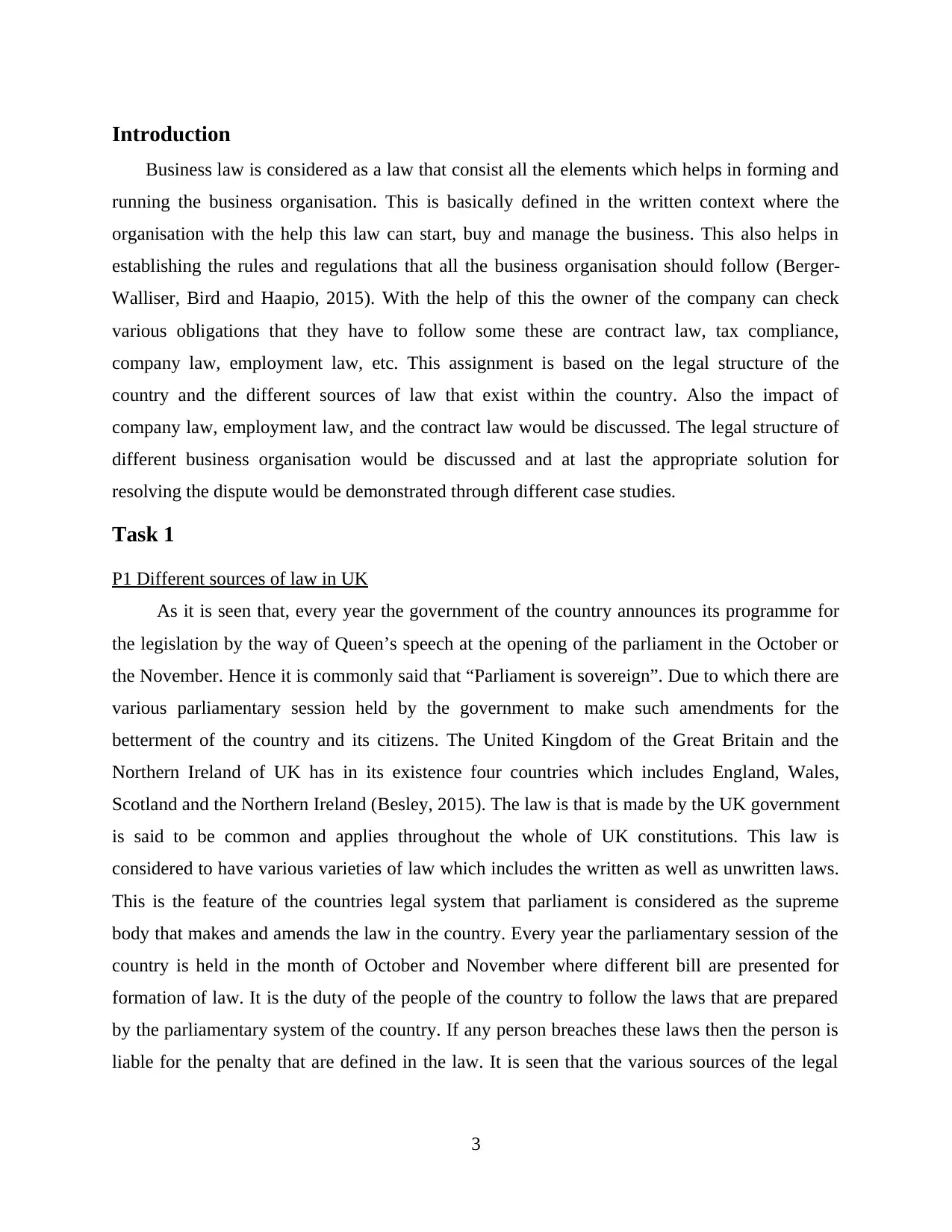
Introduction
Business law is considered as a law that consist all the elements which helps in forming and
running the business organisation. This is basically defined in the written context where the
organisation with the help this law can start, buy and manage the business. This also helps in
establishing the rules and regulations that all the business organisation should follow (Berger-
Walliser, Bird and Haapio, 2015). With the help of this the owner of the company can check
various obligations that they have to follow some these are contract law, tax compliance,
company law, employment law, etc. This assignment is based on the legal structure of the
country and the different sources of law that exist within the country. Also the impact of
company law, employment law, and the contract law would be discussed. The legal structure of
different business organisation would be discussed and at last the appropriate solution for
resolving the dispute would be demonstrated through different case studies.
Task 1
P1 Different sources of law in UK
As it is seen that, every year the government of the country announces its programme for
the legislation by the way of Queen’s speech at the opening of the parliament in the October or
the November. Hence it is commonly said that “Parliament is sovereign”. Due to which there are
various parliamentary session held by the government to make such amendments for the
betterment of the country and its citizens. The United Kingdom of the Great Britain and the
Northern Ireland of UK has in its existence four countries which includes England, Wales,
Scotland and the Northern Ireland (Besley, 2015). The law is that is made by the UK government
is said to be common and applies throughout the whole of UK constitutions. This law is
considered to have various varieties of law which includes the written as well as unwritten laws.
This is the feature of the countries legal system that parliament is considered as the supreme
body that makes and amends the law in the country. Every year the parliamentary session of the
country is held in the month of October and November where different bill are presented for
formation of law. It is the duty of the people of the country to follow the laws that are prepared
by the parliamentary system of the country. If any person breaches these laws then the person is
liable for the penalty that are defined in the law. It is seen that the various sources of the legal
3
Business law is considered as a law that consist all the elements which helps in forming and
running the business organisation. This is basically defined in the written context where the
organisation with the help this law can start, buy and manage the business. This also helps in
establishing the rules and regulations that all the business organisation should follow (Berger-
Walliser, Bird and Haapio, 2015). With the help of this the owner of the company can check
various obligations that they have to follow some these are contract law, tax compliance,
company law, employment law, etc. This assignment is based on the legal structure of the
country and the different sources of law that exist within the country. Also the impact of
company law, employment law, and the contract law would be discussed. The legal structure of
different business organisation would be discussed and at last the appropriate solution for
resolving the dispute would be demonstrated through different case studies.
Task 1
P1 Different sources of law in UK
As it is seen that, every year the government of the country announces its programme for
the legislation by the way of Queen’s speech at the opening of the parliament in the October or
the November. Hence it is commonly said that “Parliament is sovereign”. Due to which there are
various parliamentary session held by the government to make such amendments for the
betterment of the country and its citizens. The United Kingdom of the Great Britain and the
Northern Ireland of UK has in its existence four countries which includes England, Wales,
Scotland and the Northern Ireland (Besley, 2015). The law is that is made by the UK government
is said to be common and applies throughout the whole of UK constitutions. This law is
considered to have various varieties of law which includes the written as well as unwritten laws.
This is the feature of the countries legal system that parliament is considered as the supreme
body that makes and amends the law in the country. Every year the parliamentary session of the
country is held in the month of October and November where different bill are presented for
formation of law. It is the duty of the people of the country to follow the laws that are prepared
by the parliamentary system of the country. If any person breaches these laws then the person is
liable for the penalty that are defined in the law. It is seen that the various sources of the legal
3
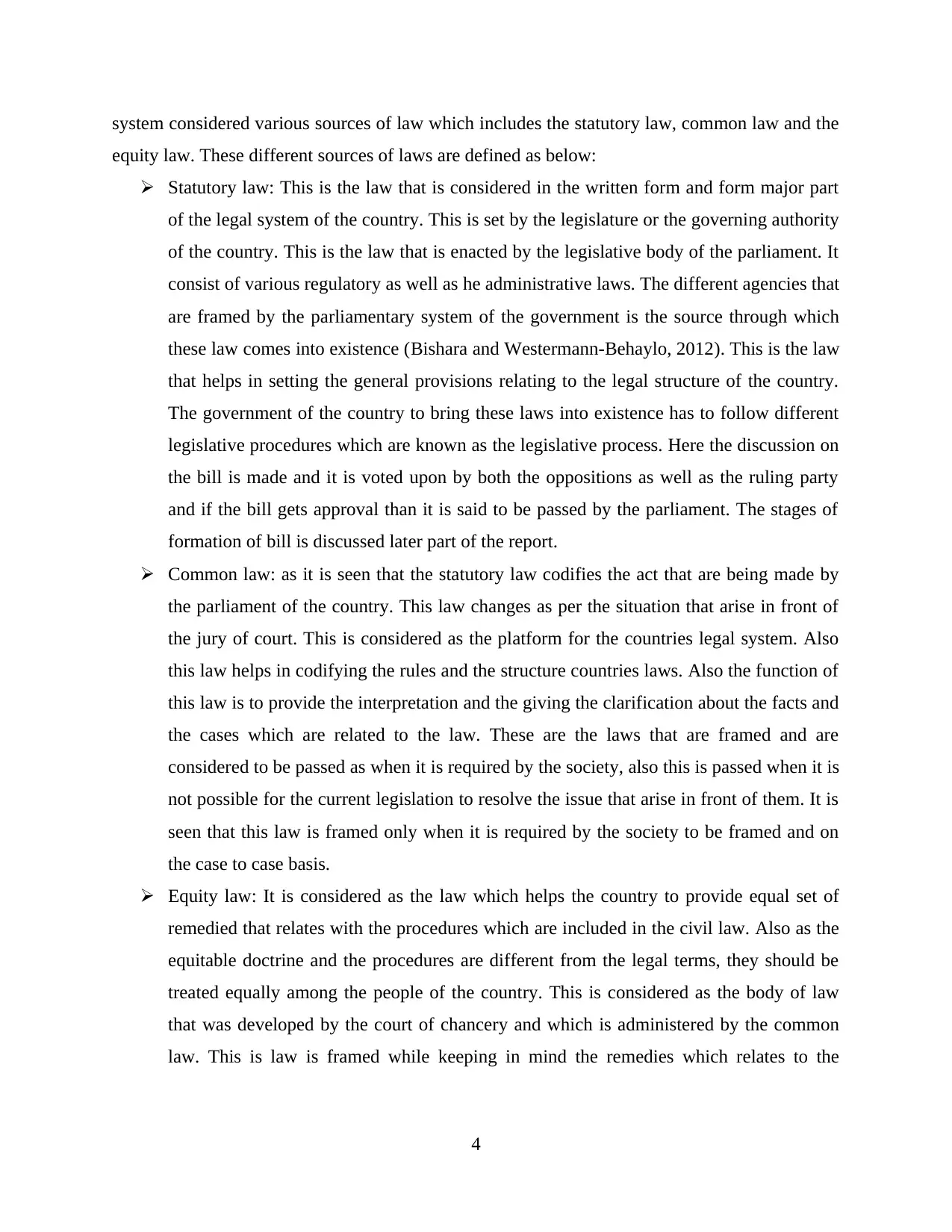
system considered various sources of law which includes the statutory law, common law and the
equity law. These different sources of laws are defined as below:
Statutory law: This is the law that is considered in the written form and form major part
of the legal system of the country. This is set by the legislature or the governing authority
of the country. This is the law that is enacted by the legislative body of the parliament. It
consist of various regulatory as well as he administrative laws. The different agencies that
are framed by the parliamentary system of the government is the source through which
these law comes into existence (Bishara and Westermann‐Behaylo, 2012). This is the law
that helps in setting the general provisions relating to the legal structure of the country.
The government of the country to bring these laws into existence has to follow different
legislative procedures which are known as the legislative process. Here the discussion on
the bill is made and it is voted upon by both the oppositions as well as the ruling party
and if the bill gets approval than it is said to be passed by the parliament. The stages of
formation of bill is discussed later part of the report.
Common law: as it is seen that the statutory law codifies the act that are being made by
the parliament of the country. This law changes as per the situation that arise in front of
the jury of court. This is considered as the platform for the countries legal system. Also
this law helps in codifying the rules and the structure countries laws. Also the function of
this law is to provide the interpretation and the giving the clarification about the facts and
the cases which are related to the law. These are the laws that are framed and are
considered to be passed as when it is required by the society, also this is passed when it is
not possible for the current legislation to resolve the issue that arise in front of them. It is
seen that this law is framed only when it is required by the society to be framed and on
the case to case basis.
Equity law: It is considered as the law which helps the country to provide equal set of
remedied that relates with the procedures which are included in the civil law. Also as the
equitable doctrine and the procedures are different from the legal terms, they should be
treated equally among the people of the country. This is considered as the body of law
that was developed by the court of chancery and which is administered by the common
law. This is law is framed while keeping in mind the remedies which relates to the
4
equity law. These different sources of laws are defined as below:
Statutory law: This is the law that is considered in the written form and form major part
of the legal system of the country. This is set by the legislature or the governing authority
of the country. This is the law that is enacted by the legislative body of the parliament. It
consist of various regulatory as well as he administrative laws. The different agencies that
are framed by the parliamentary system of the government is the source through which
these law comes into existence (Bishara and Westermann‐Behaylo, 2012). This is the law
that helps in setting the general provisions relating to the legal structure of the country.
The government of the country to bring these laws into existence has to follow different
legislative procedures which are known as the legislative process. Here the discussion on
the bill is made and it is voted upon by both the oppositions as well as the ruling party
and if the bill gets approval than it is said to be passed by the parliament. The stages of
formation of bill is discussed later part of the report.
Common law: as it is seen that the statutory law codifies the act that are being made by
the parliament of the country. This law changes as per the situation that arise in front of
the jury of court. This is considered as the platform for the countries legal system. Also
this law helps in codifying the rules and the structure countries laws. Also the function of
this law is to provide the interpretation and the giving the clarification about the facts and
the cases which are related to the law. These are the laws that are framed and are
considered to be passed as when it is required by the society, also this is passed when it is
not possible for the current legislation to resolve the issue that arise in front of them. It is
seen that this law is framed only when it is required by the society to be framed and on
the case to case basis.
Equity law: It is considered as the law which helps the country to provide equal set of
remedied that relates with the procedures which are included in the civil law. Also as the
equitable doctrine and the procedures are different from the legal terms, they should be
treated equally among the people of the country. This is considered as the body of law
that was developed by the court of chancery and which is administered by the common
law. This is law is framed while keeping in mind the remedies which relates to the
4
Secure Best Marks with AI Grader
Need help grading? Try our AI Grader for instant feedback on your assignments.
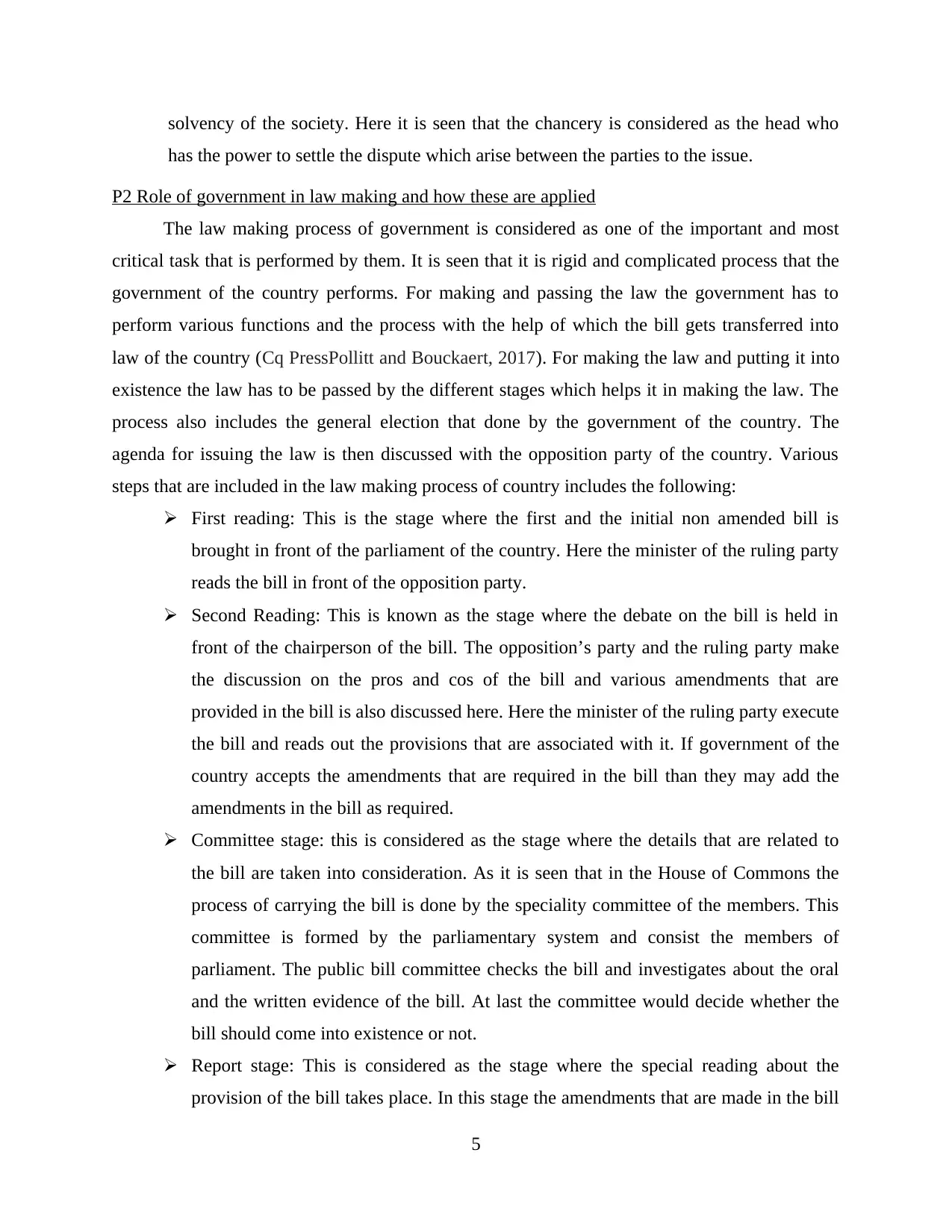
solvency of the society. Here it is seen that the chancery is considered as the head who
has the power to settle the dispute which arise between the parties to the issue.
P2 Role of government in law making and how these are applied
The law making process of government is considered as one of the important and most
critical task that is performed by them. It is seen that it is rigid and complicated process that the
government of the country performs. For making and passing the law the government has to
perform various functions and the process with the help of which the bill gets transferred into
law of the country (Cq PressPollitt and Bouckaert, 2017). For making the law and putting it into
existence the law has to be passed by the different stages which helps it in making the law. The
process also includes the general election that done by the government of the country. The
agenda for issuing the law is then discussed with the opposition party of the country. Various
steps that are included in the law making process of country includes the following:
First reading: This is the stage where the first and the initial non amended bill is
brought in front of the parliament of the country. Here the minister of the ruling party
reads the bill in front of the opposition party.
Second Reading: This is known as the stage where the debate on the bill is held in
front of the chairperson of the bill. The opposition’s party and the ruling party make
the discussion on the pros and cos of the bill and various amendments that are
provided in the bill is also discussed here. Here the minister of the ruling party execute
the bill and reads out the provisions that are associated with it. If government of the
country accepts the amendments that are required in the bill than they may add the
amendments in the bill as required.
Committee stage: this is considered as the stage where the details that are related to
the bill are taken into consideration. As it is seen that in the House of Commons the
process of carrying the bill is done by the speciality committee of the members. This
committee is formed by the parliamentary system and consist the members of
parliament. The public bill committee checks the bill and investigates about the oral
and the written evidence of the bill. At last the committee would decide whether the
bill should come into existence or not.
Report stage: This is considered as the stage where the special reading about the
provision of the bill takes place. In this stage the amendments that are made in the bill
5
has the power to settle the dispute which arise between the parties to the issue.
P2 Role of government in law making and how these are applied
The law making process of government is considered as one of the important and most
critical task that is performed by them. It is seen that it is rigid and complicated process that the
government of the country performs. For making and passing the law the government has to
perform various functions and the process with the help of which the bill gets transferred into
law of the country (Cq PressPollitt and Bouckaert, 2017). For making the law and putting it into
existence the law has to be passed by the different stages which helps it in making the law. The
process also includes the general election that done by the government of the country. The
agenda for issuing the law is then discussed with the opposition party of the country. Various
steps that are included in the law making process of country includes the following:
First reading: This is the stage where the first and the initial non amended bill is
brought in front of the parliament of the country. Here the minister of the ruling party
reads the bill in front of the opposition party.
Second Reading: This is known as the stage where the debate on the bill is held in
front of the chairperson of the bill. The opposition’s party and the ruling party make
the discussion on the pros and cos of the bill and various amendments that are
provided in the bill is also discussed here. Here the minister of the ruling party execute
the bill and reads out the provisions that are associated with it. If government of the
country accepts the amendments that are required in the bill than they may add the
amendments in the bill as required.
Committee stage: this is considered as the stage where the details that are related to
the bill are taken into consideration. As it is seen that in the House of Commons the
process of carrying the bill is done by the speciality committee of the members. This
committee is formed by the parliamentary system and consist the members of
parliament. The public bill committee checks the bill and investigates about the oral
and the written evidence of the bill. At last the committee would decide whether the
bill should come into existence or not.
Report stage: This is considered as the stage where the special reading about the
provision of the bill takes place. In this stage the amendments that are made in the bill
5
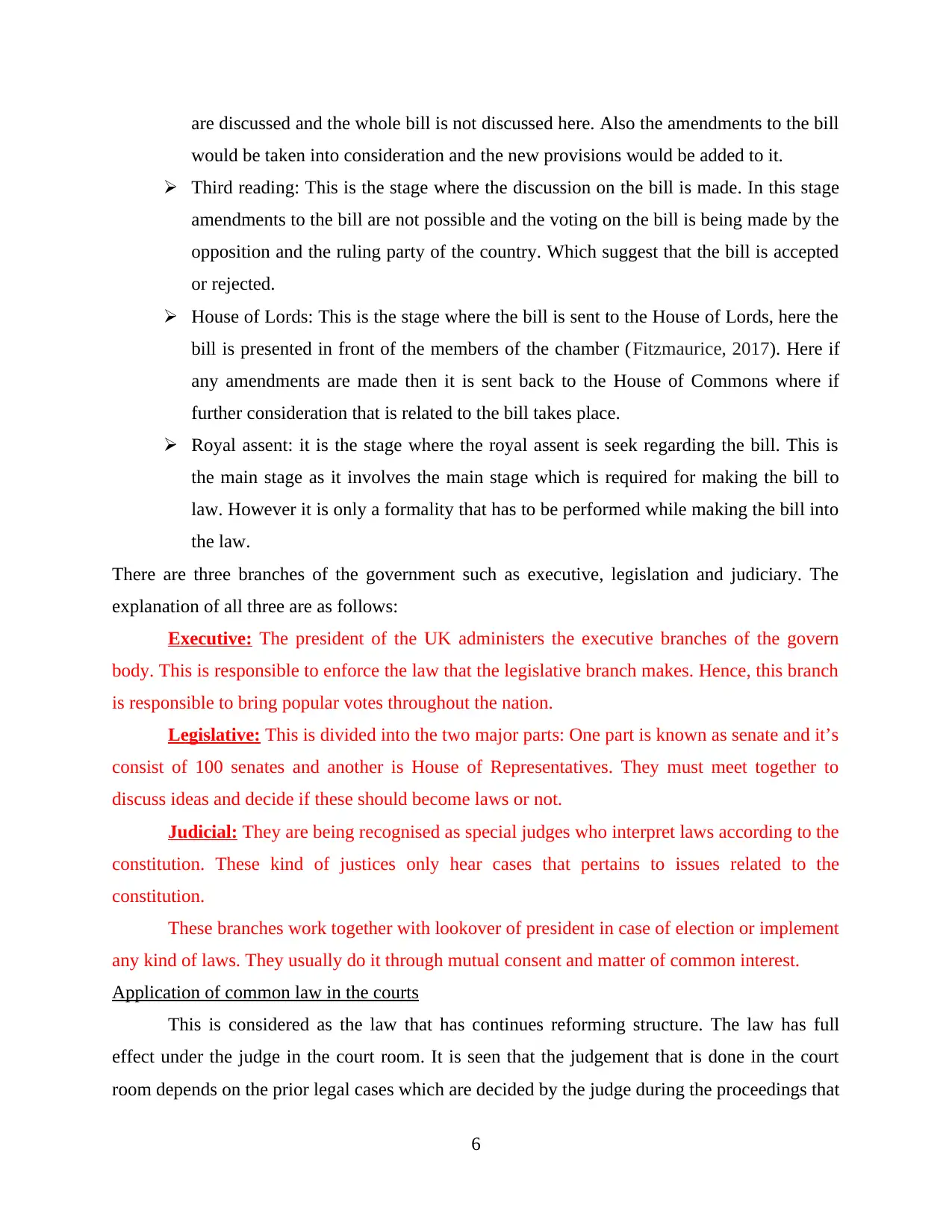
are discussed and the whole bill is not discussed here. Also the amendments to the bill
would be taken into consideration and the new provisions would be added to it.
Third reading: This is the stage where the discussion on the bill is made. In this stage
amendments to the bill are not possible and the voting on the bill is being made by the
opposition and the ruling party of the country. Which suggest that the bill is accepted
or rejected.
House of Lords: This is the stage where the bill is sent to the House of Lords, here the
bill is presented in front of the members of the chamber (Fitzmaurice, 2017). Here if
any amendments are made then it is sent back to the House of Commons where if
further consideration that is related to the bill takes place.
Royal assent: it is the stage where the royal assent is seek regarding the bill. This is
the main stage as it involves the main stage which is required for making the bill to
law. However it is only a formality that has to be performed while making the bill into
the law.
There are three branches of the government such as executive, legislation and judiciary. The
explanation of all three are as follows:
Executive: The president of the UK administers the executive branches of the govern
body. This is responsible to enforce the law that the legislative branch makes. Hence, this branch
is responsible to bring popular votes throughout the nation.
Legislative: This is divided into the two major parts: One part is known as senate and it’s
consist of 100 senates and another is House of Representatives. They must meet together to
discuss ideas and decide if these should become laws or not.
Judicial: They are being recognised as special judges who interpret laws according to the
constitution. These kind of justices only hear cases that pertains to issues related to the
constitution.
These branches work together with lookover of president in case of election or implement
any kind of laws. They usually do it through mutual consent and matter of common interest.
Application of common law in the courts
This is considered as the law that has continues reforming structure. The law has full
effect under the judge in the court room. It is seen that the judgement that is done in the court
room depends on the prior legal cases which are decided by the judge during the proceedings that
6
would be taken into consideration and the new provisions would be added to it.
Third reading: This is the stage where the discussion on the bill is made. In this stage
amendments to the bill are not possible and the voting on the bill is being made by the
opposition and the ruling party of the country. Which suggest that the bill is accepted
or rejected.
House of Lords: This is the stage where the bill is sent to the House of Lords, here the
bill is presented in front of the members of the chamber (Fitzmaurice, 2017). Here if
any amendments are made then it is sent back to the House of Commons where if
further consideration that is related to the bill takes place.
Royal assent: it is the stage where the royal assent is seek regarding the bill. This is
the main stage as it involves the main stage which is required for making the bill to
law. However it is only a formality that has to be performed while making the bill into
the law.
There are three branches of the government such as executive, legislation and judiciary. The
explanation of all three are as follows:
Executive: The president of the UK administers the executive branches of the govern
body. This is responsible to enforce the law that the legislative branch makes. Hence, this branch
is responsible to bring popular votes throughout the nation.
Legislative: This is divided into the two major parts: One part is known as senate and it’s
consist of 100 senates and another is House of Representatives. They must meet together to
discuss ideas and decide if these should become laws or not.
Judicial: They are being recognised as special judges who interpret laws according to the
constitution. These kind of justices only hear cases that pertains to issues related to the
constitution.
These branches work together with lookover of president in case of election or implement
any kind of laws. They usually do it through mutual consent and matter of common interest.
Application of common law in the courts
This is considered as the law that has continues reforming structure. The law has full
effect under the judge in the court room. It is seen that the judgement that is done in the court
room depends on the prior legal cases which are decided by the judge during the proceedings that
6
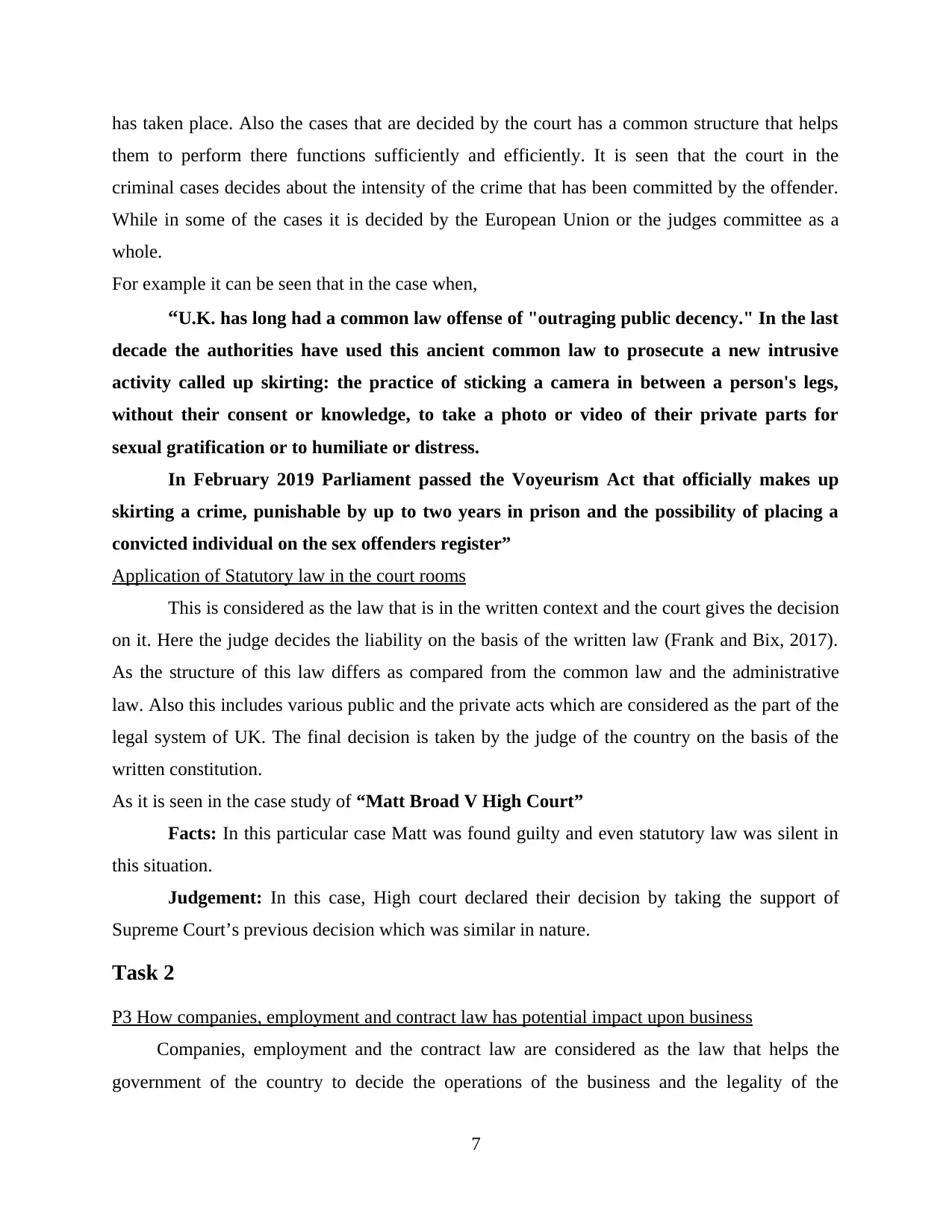
has taken place. Also the cases that are decided by the court has a common structure that helps
them to perform there functions sufficiently and efficiently. It is seen that the court in the
criminal cases decides about the intensity of the crime that has been committed by the offender.
While in some of the cases it is decided by the European Union or the judges committee as a
whole.
For example it can be seen that in the case when,
“U.K. has long had a common law offense of "outraging public decency." In the last
decade the authorities have used this ancient common law to prosecute a new intrusive
activity called up skirting: the practice of sticking a camera in between a person's legs,
without their consent or knowledge, to take a photo or video of their private parts for
sexual gratification or to humiliate or distress.
In February 2019 Parliament passed the Voyeurism Act that officially makes up
skirting a crime, punishable by up to two years in prison and the possibility of placing a
convicted individual on the sex offenders register”
Application of Statutory law in the court rooms
This is considered as the law that is in the written context and the court gives the decision
on it. Here the judge decides the liability on the basis of the written law (Frank and Bix, 2017).
As the structure of this law differs as compared from the common law and the administrative
law. Also this includes various public and the private acts which are considered as the part of the
legal system of UK. The final decision is taken by the judge of the country on the basis of the
written constitution.
As it is seen in the case study of “Matt Broad V High Court”
Facts: In this particular case Matt was found guilty and even statutory law was silent in
this situation.
Judgement: In this case, High court declared their decision by taking the support of
Supreme Court’s previous decision which was similar in nature.
Task 2
P3 How companies, employment and contract law has potential impact upon business
Companies, employment and the contract law are considered as the law that helps the
government of the country to decide the operations of the business and the legality of the
7
them to perform there functions sufficiently and efficiently. It is seen that the court in the
criminal cases decides about the intensity of the crime that has been committed by the offender.
While in some of the cases it is decided by the European Union or the judges committee as a
whole.
For example it can be seen that in the case when,
“U.K. has long had a common law offense of "outraging public decency." In the last
decade the authorities have used this ancient common law to prosecute a new intrusive
activity called up skirting: the practice of sticking a camera in between a person's legs,
without their consent or knowledge, to take a photo or video of their private parts for
sexual gratification or to humiliate or distress.
In February 2019 Parliament passed the Voyeurism Act that officially makes up
skirting a crime, punishable by up to two years in prison and the possibility of placing a
convicted individual on the sex offenders register”
Application of Statutory law in the court rooms
This is considered as the law that is in the written context and the court gives the decision
on it. Here the judge decides the liability on the basis of the written law (Frank and Bix, 2017).
As the structure of this law differs as compared from the common law and the administrative
law. Also this includes various public and the private acts which are considered as the part of the
legal system of UK. The final decision is taken by the judge of the country on the basis of the
written constitution.
As it is seen in the case study of “Matt Broad V High Court”
Facts: In this particular case Matt was found guilty and even statutory law was silent in
this situation.
Judgement: In this case, High court declared their decision by taking the support of
Supreme Court’s previous decision which was similar in nature.
Task 2
P3 How companies, employment and contract law has potential impact upon business
Companies, employment and the contract law are considered as the law that helps the
government of the country to decide the operations of the business and the legality of the
7
Paraphrase This Document
Need a fresh take? Get an instant paraphrase of this document with our AI Paraphraser
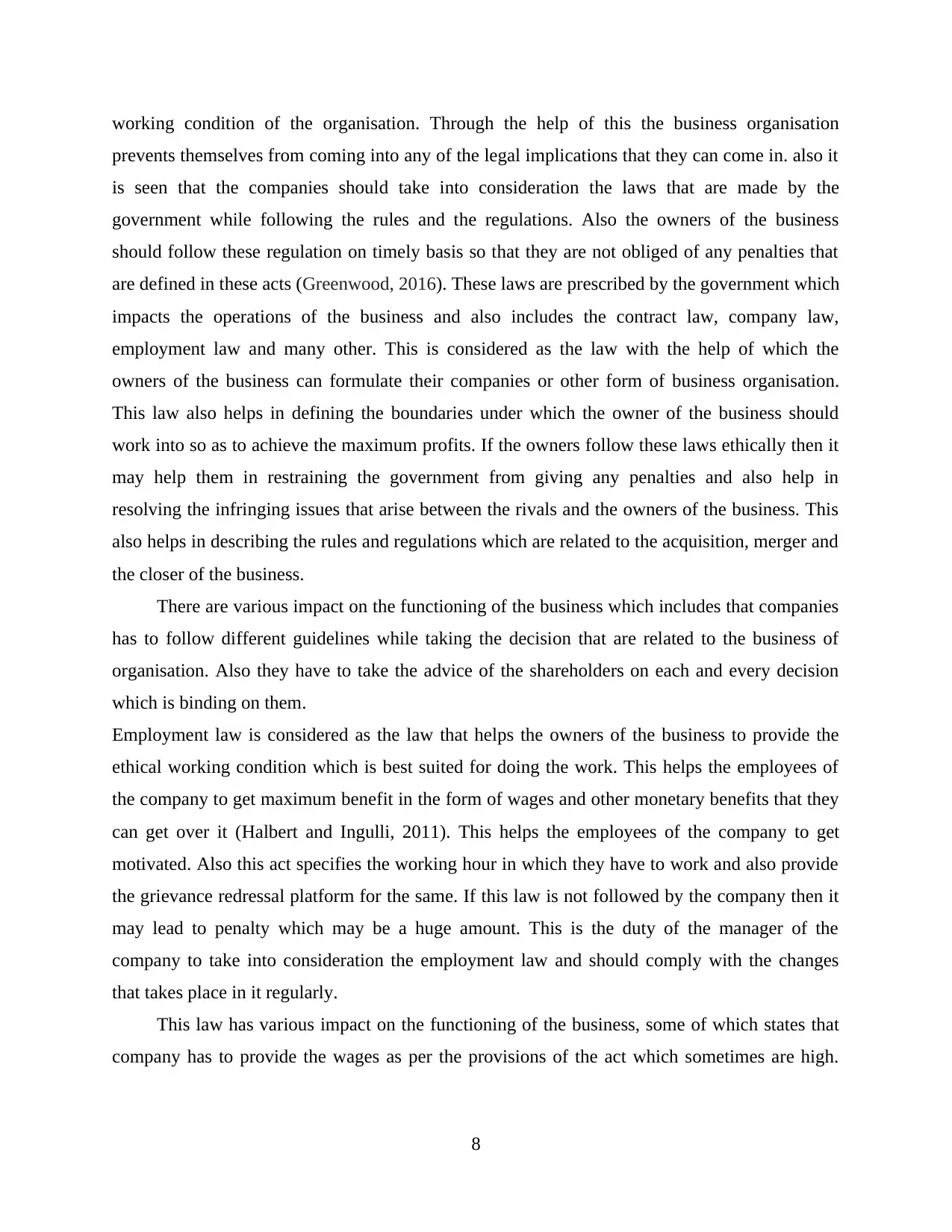
working condition of the organisation. Through the help of this the business organisation
prevents themselves from coming into any of the legal implications that they can come in. also it
is seen that the companies should take into consideration the laws that are made by the
government while following the rules and the regulations. Also the owners of the business
should follow these regulation on timely basis so that they are not obliged of any penalties that
are defined in these acts (Greenwood, 2016). These laws are prescribed by the government which
impacts the operations of the business and also includes the contract law, company law,
employment law and many other. This is considered as the law with the help of which the
owners of the business can formulate their companies or other form of business organisation.
This law also helps in defining the boundaries under which the owner of the business should
work into so as to achieve the maximum profits. If the owners follow these laws ethically then it
may help them in restraining the government from giving any penalties and also help in
resolving the infringing issues that arise between the rivals and the owners of the business. This
also helps in describing the rules and regulations which are related to the acquisition, merger and
the closer of the business.
There are various impact on the functioning of the business which includes that companies
has to follow different guidelines while taking the decision that are related to the business of
organisation. Also they have to take the advice of the shareholders on each and every decision
which is binding on them.
Employment law is considered as the law that helps the owners of the business to provide the
ethical working condition which is best suited for doing the work. This helps the employees of
the company to get maximum benefit in the form of wages and other monetary benefits that they
can get over it (Halbert and Ingulli, 2011). This helps the employees of the company to get
motivated. Also this act specifies the working hour in which they have to work and also provide
the grievance redressal platform for the same. If this law is not followed by the company then it
may lead to penalty which may be a huge amount. This is the duty of the manager of the
company to take into consideration the employment law and should comply with the changes
that takes place in it regularly.
This law has various impact on the functioning of the business, some of which states that
company has to provide the wages as per the provisions of the act which sometimes are high.
8
prevents themselves from coming into any of the legal implications that they can come in. also it
is seen that the companies should take into consideration the laws that are made by the
government while following the rules and the regulations. Also the owners of the business
should follow these regulation on timely basis so that they are not obliged of any penalties that
are defined in these acts (Greenwood, 2016). These laws are prescribed by the government which
impacts the operations of the business and also includes the contract law, company law,
employment law and many other. This is considered as the law with the help of which the
owners of the business can formulate their companies or other form of business organisation.
This law also helps in defining the boundaries under which the owner of the business should
work into so as to achieve the maximum profits. If the owners follow these laws ethically then it
may help them in restraining the government from giving any penalties and also help in
resolving the infringing issues that arise between the rivals and the owners of the business. This
also helps in describing the rules and regulations which are related to the acquisition, merger and
the closer of the business.
There are various impact on the functioning of the business which includes that companies
has to follow different guidelines while taking the decision that are related to the business of
organisation. Also they have to take the advice of the shareholders on each and every decision
which is binding on them.
Employment law is considered as the law that helps the owners of the business to provide the
ethical working condition which is best suited for doing the work. This helps the employees of
the company to get maximum benefit in the form of wages and other monetary benefits that they
can get over it (Halbert and Ingulli, 2011). This helps the employees of the company to get
motivated. Also this act specifies the working hour in which they have to work and also provide
the grievance redressal platform for the same. If this law is not followed by the company then it
may lead to penalty which may be a huge amount. This is the duty of the manager of the
company to take into consideration the employment law and should comply with the changes
that takes place in it regularly.
This law has various impact on the functioning of the business, some of which states that
company has to provide the wages as per the provisions of the act which sometimes are high.
8
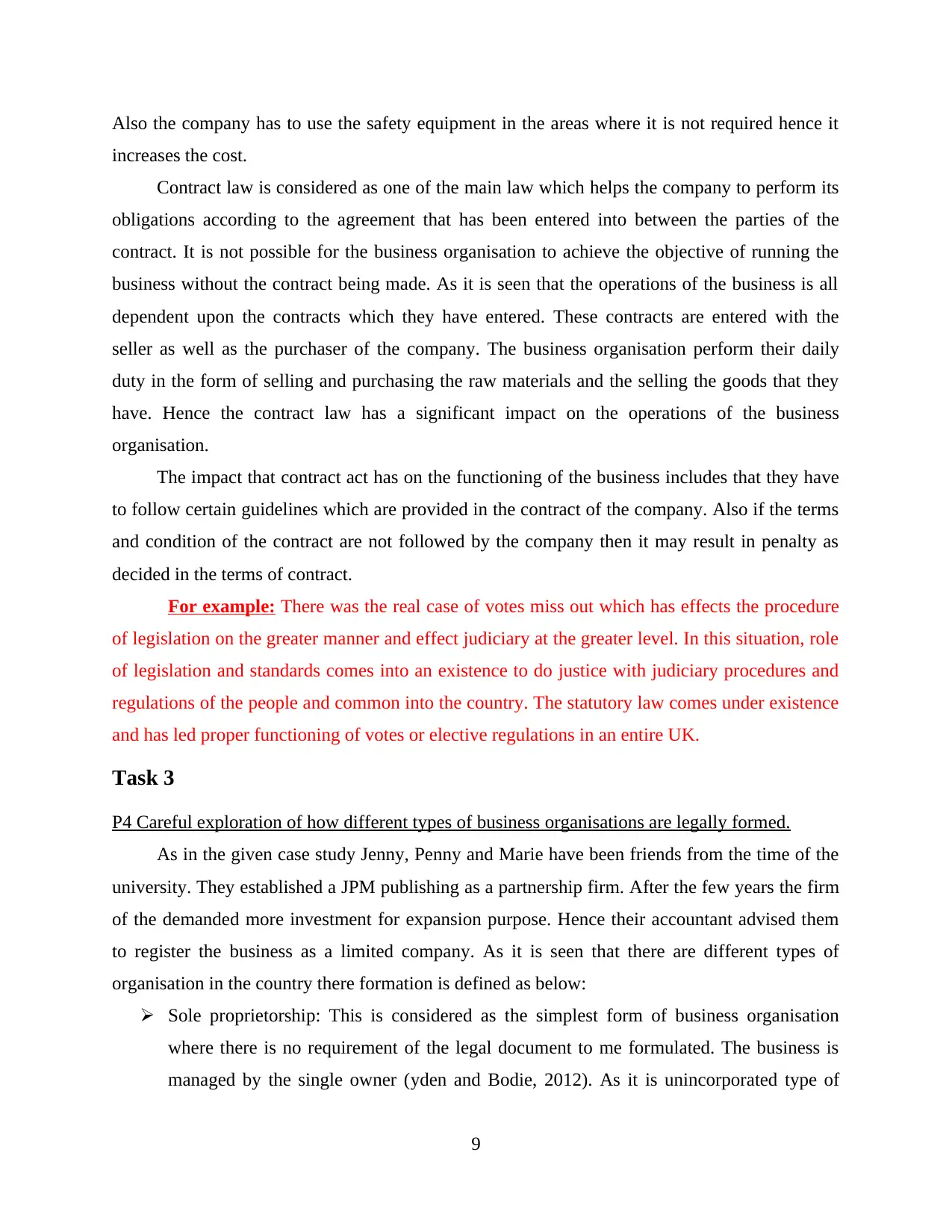
Also the company has to use the safety equipment in the areas where it is not required hence it
increases the cost.
Contract law is considered as one of the main law which helps the company to perform its
obligations according to the agreement that has been entered into between the parties of the
contract. It is not possible for the business organisation to achieve the objective of running the
business without the contract being made. As it is seen that the operations of the business is all
dependent upon the contracts which they have entered. These contracts are entered with the
seller as well as the purchaser of the company. The business organisation perform their daily
duty in the form of selling and purchasing the raw materials and the selling the goods that they
have. Hence the contract law has a significant impact on the operations of the business
organisation.
The impact that contract act has on the functioning of the business includes that they have
to follow certain guidelines which are provided in the contract of the company. Also if the terms
and condition of the contract are not followed by the company then it may result in penalty as
decided in the terms of contract.
For example: There was the real case of votes miss out which has effects the procedure
of legislation on the greater manner and effect judiciary at the greater level. In this situation, role
of legislation and standards comes into an existence to do justice with judiciary procedures and
regulations of the people and common into the country. The statutory law comes under existence
and has led proper functioning of votes or elective regulations in an entire UK.
Task 3
P4 Careful exploration of how different types of business organisations are legally formed.
As in the given case study Jenny, Penny and Marie have been friends from the time of the
university. They established a JPM publishing as a partnership firm. After the few years the firm
of the demanded more investment for expansion purpose. Hence their accountant advised them
to register the business as a limited company. As it is seen that there are different types of
organisation in the country there formation is defined as below:
Sole proprietorship: This is considered as the simplest form of business organisation
where there is no requirement of the legal document to me formulated. The business is
managed by the single owner (yden and Bodie, 2012). As it is unincorporated type of
9
increases the cost.
Contract law is considered as one of the main law which helps the company to perform its
obligations according to the agreement that has been entered into between the parties of the
contract. It is not possible for the business organisation to achieve the objective of running the
business without the contract being made. As it is seen that the operations of the business is all
dependent upon the contracts which they have entered. These contracts are entered with the
seller as well as the purchaser of the company. The business organisation perform their daily
duty in the form of selling and purchasing the raw materials and the selling the goods that they
have. Hence the contract law has a significant impact on the operations of the business
organisation.
The impact that contract act has on the functioning of the business includes that they have
to follow certain guidelines which are provided in the contract of the company. Also if the terms
and condition of the contract are not followed by the company then it may result in penalty as
decided in the terms of contract.
For example: There was the real case of votes miss out which has effects the procedure
of legislation on the greater manner and effect judiciary at the greater level. In this situation, role
of legislation and standards comes into an existence to do justice with judiciary procedures and
regulations of the people and common into the country. The statutory law comes under existence
and has led proper functioning of votes or elective regulations in an entire UK.
Task 3
P4 Careful exploration of how different types of business organisations are legally formed.
As in the given case study Jenny, Penny and Marie have been friends from the time of the
university. They established a JPM publishing as a partnership firm. After the few years the firm
of the demanded more investment for expansion purpose. Hence their accountant advised them
to register the business as a limited company. As it is seen that there are different types of
organisation in the country there formation is defined as below:
Sole proprietorship: This is considered as the simplest form of business organisation
where there is no requirement of the legal document to me formulated. The business is
managed by the single owner (yden and Bodie, 2012). As it is unincorporated type of
9
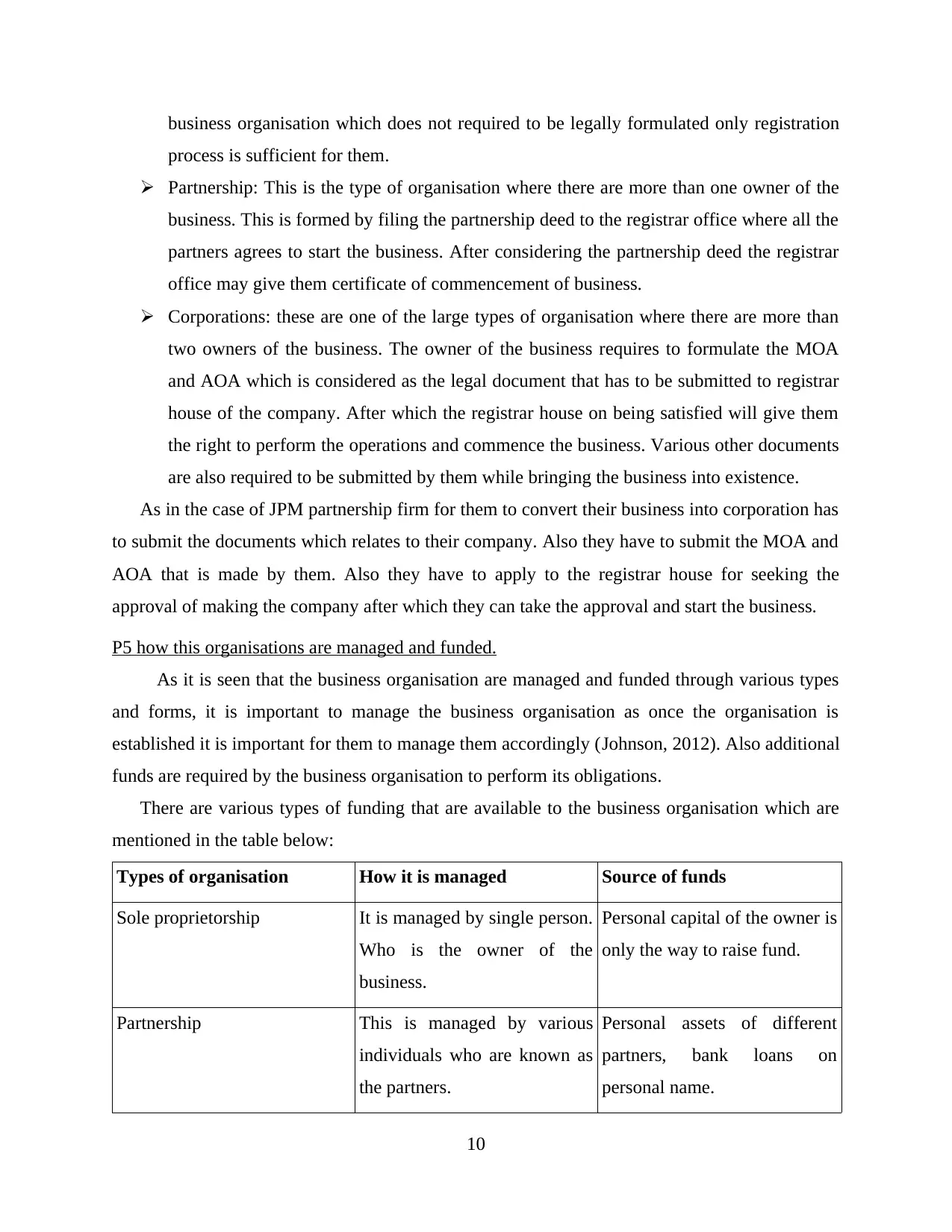
business organisation which does not required to be legally formulated only registration
process is sufficient for them.
Partnership: This is the type of organisation where there are more than one owner of the
business. This is formed by filing the partnership deed to the registrar office where all the
partners agrees to start the business. After considering the partnership deed the registrar
office may give them certificate of commencement of business.
Corporations: these are one of the large types of organisation where there are more than
two owners of the business. The owner of the business requires to formulate the MOA
and AOA which is considered as the legal document that has to be submitted to registrar
house of the company. After which the registrar house on being satisfied will give them
the right to perform the operations and commence the business. Various other documents
are also required to be submitted by them while bringing the business into existence.
As in the case of JPM partnership firm for them to convert their business into corporation has
to submit the documents which relates to their company. Also they have to submit the MOA and
AOA that is made by them. Also they have to apply to the registrar house for seeking the
approval of making the company after which they can take the approval and start the business.
P5 how this organisations are managed and funded.
As it is seen that the business organisation are managed and funded through various types
and forms, it is important to manage the business organisation as once the organisation is
established it is important for them to manage them accordingly (Johnson, 2012). Also additional
funds are required by the business organisation to perform its obligations.
There are various types of funding that are available to the business organisation which are
mentioned in the table below:
Types of organisation How it is managed Source of funds
Sole proprietorship It is managed by single person.
Who is the owner of the
business.
Personal capital of the owner is
only the way to raise fund.
Partnership This is managed by various
individuals who are known as
the partners.
Personal assets of different
partners, bank loans on
personal name.
10
process is sufficient for them.
Partnership: This is the type of organisation where there are more than one owner of the
business. This is formed by filing the partnership deed to the registrar office where all the
partners agrees to start the business. After considering the partnership deed the registrar
office may give them certificate of commencement of business.
Corporations: these are one of the large types of organisation where there are more than
two owners of the business. The owner of the business requires to formulate the MOA
and AOA which is considered as the legal document that has to be submitted to registrar
house of the company. After which the registrar house on being satisfied will give them
the right to perform the operations and commence the business. Various other documents
are also required to be submitted by them while bringing the business into existence.
As in the case of JPM partnership firm for them to convert their business into corporation has
to submit the documents which relates to their company. Also they have to submit the MOA and
AOA that is made by them. Also they have to apply to the registrar house for seeking the
approval of making the company after which they can take the approval and start the business.
P5 how this organisations are managed and funded.
As it is seen that the business organisation are managed and funded through various types
and forms, it is important to manage the business organisation as once the organisation is
established it is important for them to manage them accordingly (Johnson, 2012). Also additional
funds are required by the business organisation to perform its obligations.
There are various types of funding that are available to the business organisation which are
mentioned in the table below:
Types of organisation How it is managed Source of funds
Sole proprietorship It is managed by single person.
Who is the owner of the
business.
Personal capital of the owner is
only the way to raise fund.
Partnership This is managed by various
individuals who are known as
the partners.
Personal assets of different
partners, bank loans on
personal name.
10
Secure Best Marks with AI Grader
Need help grading? Try our AI Grader for instant feedback on your assignments.
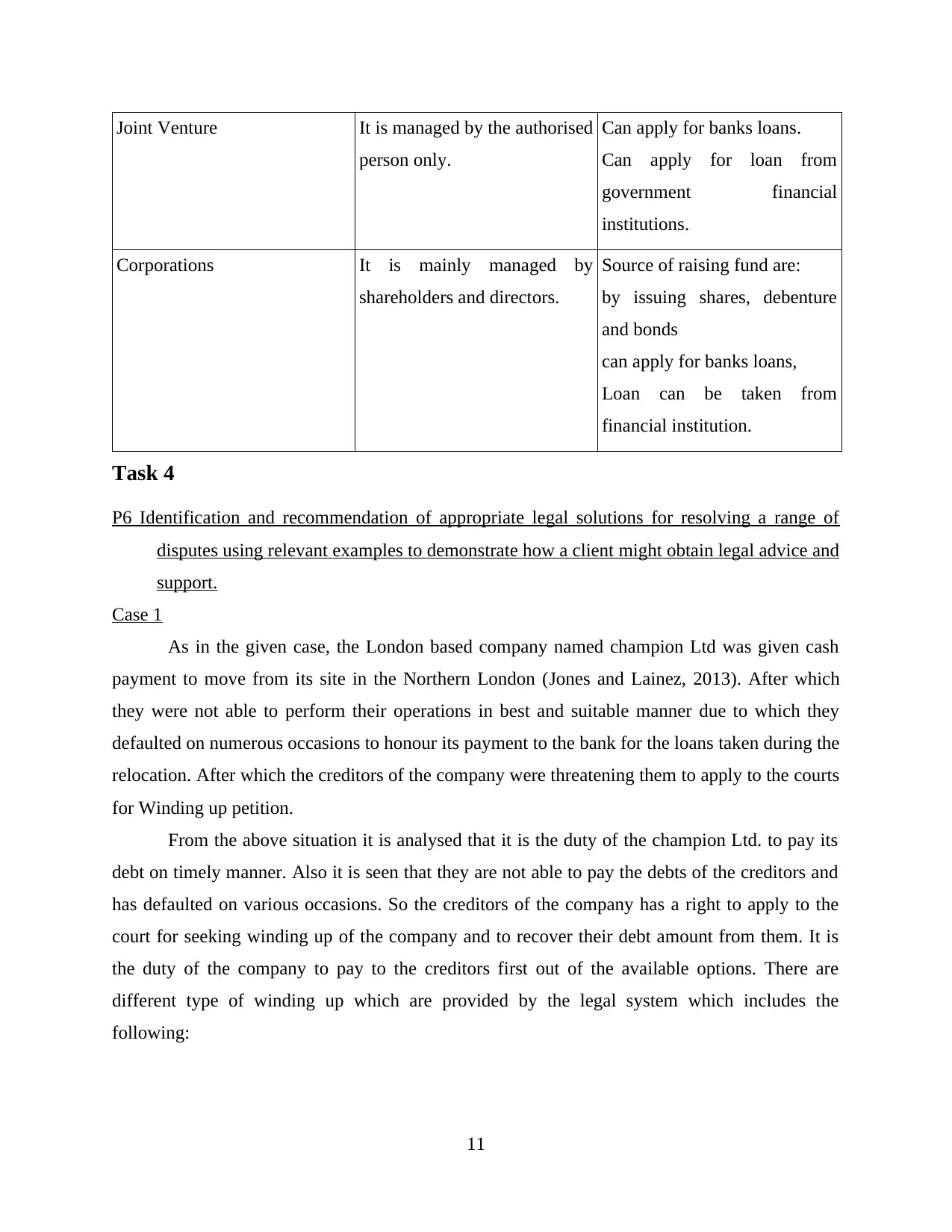
Joint Venture It is managed by the authorised
person only.
Can apply for banks loans.
Can apply for loan from
government financial
institutions.
Corporations It is mainly managed by
shareholders and directors.
Source of raising fund are:
by issuing shares, debenture
and bonds
can apply for banks loans,
Loan can be taken from
financial institution.
Task 4
P6 Identification and recommendation of appropriate legal solutions for resolving a range of
disputes using relevant examples to demonstrate how a client might obtain legal advice and
support.
Case 1
As in the given case, the London based company named champion Ltd was given cash
payment to move from its site in the Northern London (Jones and Lainez, 2013). After which
they were not able to perform their operations in best and suitable manner due to which they
defaulted on numerous occasions to honour its payment to the bank for the loans taken during the
relocation. After which the creditors of the company were threatening them to apply to the courts
for Winding up petition.
From the above situation it is analysed that it is the duty of the champion Ltd. to pay its
debt on timely manner. Also it is seen that they are not able to pay the debts of the creditors and
has defaulted on various occasions. So the creditors of the company has a right to apply to the
court for seeking winding up of the company and to recover their debt amount from them. It is
the duty of the company to pay to the creditors first out of the available options. There are
different type of winding up which are provided by the legal system which includes the
following:
11
person only.
Can apply for banks loans.
Can apply for loan from
government financial
institutions.
Corporations It is mainly managed by
shareholders and directors.
Source of raising fund are:
by issuing shares, debenture
and bonds
can apply for banks loans,
Loan can be taken from
financial institution.
Task 4
P6 Identification and recommendation of appropriate legal solutions for resolving a range of
disputes using relevant examples to demonstrate how a client might obtain legal advice and
support.
Case 1
As in the given case, the London based company named champion Ltd was given cash
payment to move from its site in the Northern London (Jones and Lainez, 2013). After which
they were not able to perform their operations in best and suitable manner due to which they
defaulted on numerous occasions to honour its payment to the bank for the loans taken during the
relocation. After which the creditors of the company were threatening them to apply to the courts
for Winding up petition.
From the above situation it is analysed that it is the duty of the champion Ltd. to pay its
debt on timely manner. Also it is seen that they are not able to pay the debts of the creditors and
has defaulted on various occasions. So the creditors of the company has a right to apply to the
court for seeking winding up of the company and to recover their debt amount from them. It is
the duty of the company to pay to the creditors first out of the available options. There are
different type of winding up which are provided by the legal system which includes the
following:
11
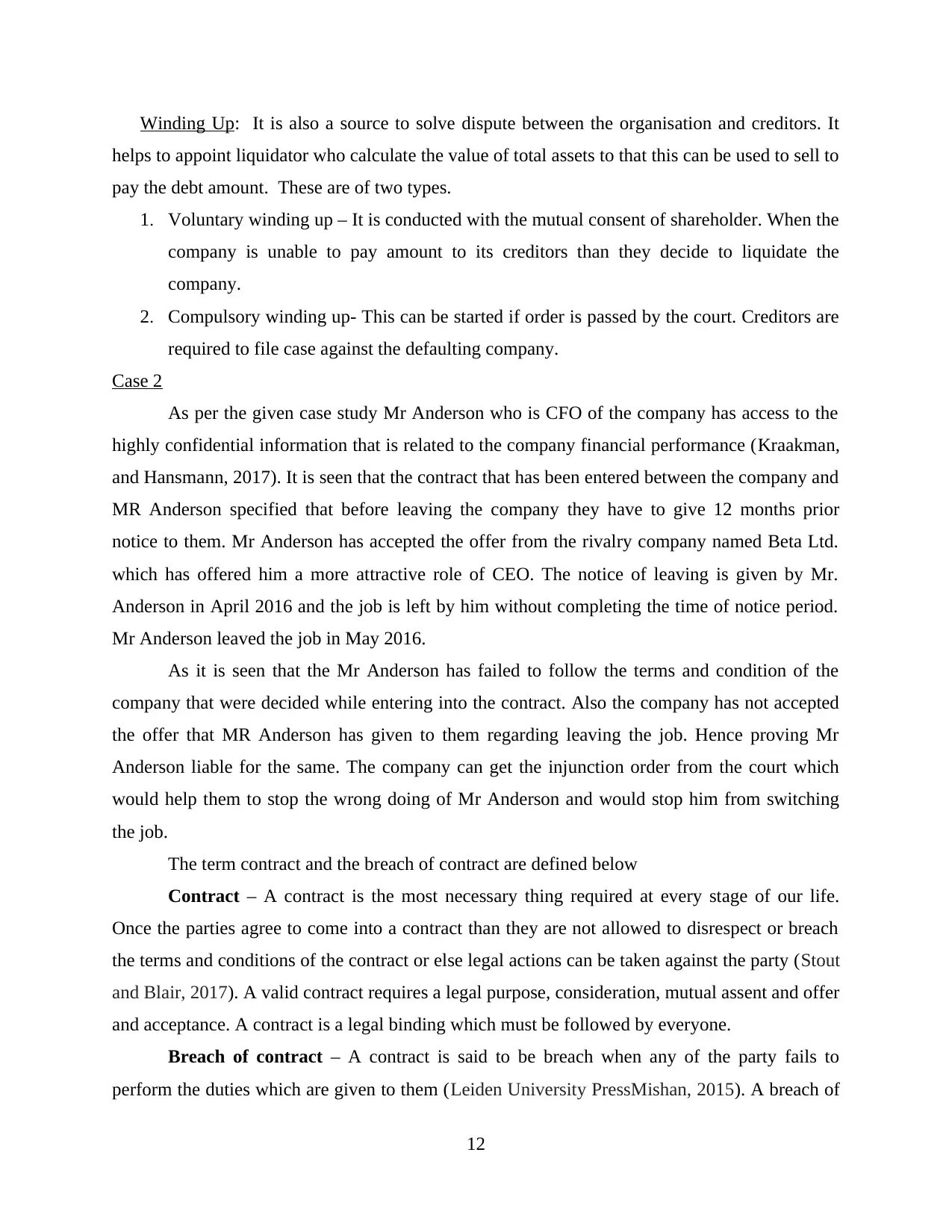
Winding Up: It is also a source to solve dispute between the organisation and creditors. It
helps to appoint liquidator who calculate the value of total assets to that this can be used to sell to
pay the debt amount. These are of two types.
1. Voluntary winding up – It is conducted with the mutual consent of shareholder. When the
company is unable to pay amount to its creditors than they decide to liquidate the
company.
2. Compulsory winding up- This can be started if order is passed by the court. Creditors are
required to file case against the defaulting company.
Case 2
As per the given case study Mr Anderson who is CFO of the company has access to the
highly confidential information that is related to the company financial performance (Kraakman,
and Hansmann, 2017). It is seen that the contract that has been entered between the company and
MR Anderson specified that before leaving the company they have to give 12 months prior
notice to them. Mr Anderson has accepted the offer from the rivalry company named Beta Ltd.
which has offered him a more attractive role of CEO. The notice of leaving is given by Mr.
Anderson in April 2016 and the job is left by him without completing the time of notice period.
Mr Anderson leaved the job in May 2016.
As it is seen that the Mr Anderson has failed to follow the terms and condition of the
company that were decided while entering into the contract. Also the company has not accepted
the offer that MR Anderson has given to them regarding leaving the job. Hence proving Mr
Anderson liable for the same. The company can get the injunction order from the court which
would help them to stop the wrong doing of Mr Anderson and would stop him from switching
the job.
The term contract and the breach of contract are defined below
Contract – A contract is the most necessary thing required at every stage of our life.
Once the parties agree to come into a contract than they are not allowed to disrespect or breach
the terms and conditions of the contract or else legal actions can be taken against the party (Stout
and Blair, 2017). A valid contract requires a legal purpose, consideration, mutual assent and offer
and acceptance. A contract is a legal binding which must be followed by everyone.
Breach of contract – A contract is said to be breach when any of the party fails to
perform the duties which are given to them (Leiden University PressMishan, 2015). A breach of
12
helps to appoint liquidator who calculate the value of total assets to that this can be used to sell to
pay the debt amount. These are of two types.
1. Voluntary winding up – It is conducted with the mutual consent of shareholder. When the
company is unable to pay amount to its creditors than they decide to liquidate the
company.
2. Compulsory winding up- This can be started if order is passed by the court. Creditors are
required to file case against the defaulting company.
Case 2
As per the given case study Mr Anderson who is CFO of the company has access to the
highly confidential information that is related to the company financial performance (Kraakman,
and Hansmann, 2017). It is seen that the contract that has been entered between the company and
MR Anderson specified that before leaving the company they have to give 12 months prior
notice to them. Mr Anderson has accepted the offer from the rivalry company named Beta Ltd.
which has offered him a more attractive role of CEO. The notice of leaving is given by Mr.
Anderson in April 2016 and the job is left by him without completing the time of notice period.
Mr Anderson leaved the job in May 2016.
As it is seen that the Mr Anderson has failed to follow the terms and condition of the
company that were decided while entering into the contract. Also the company has not accepted
the offer that MR Anderson has given to them regarding leaving the job. Hence proving Mr
Anderson liable for the same. The company can get the injunction order from the court which
would help them to stop the wrong doing of Mr Anderson and would stop him from switching
the job.
The term contract and the breach of contract are defined below
Contract – A contract is the most necessary thing required at every stage of our life.
Once the parties agree to come into a contract than they are not allowed to disrespect or breach
the terms and conditions of the contract or else legal actions can be taken against the party (Stout
and Blair, 2017). A valid contract requires a legal purpose, consideration, mutual assent and offer
and acceptance. A contract is a legal binding which must be followed by everyone.
Breach of contract – A contract is said to be breach when any of the party fails to
perform the duties which are given to them (Leiden University PressMishan, 2015). A breach of
12
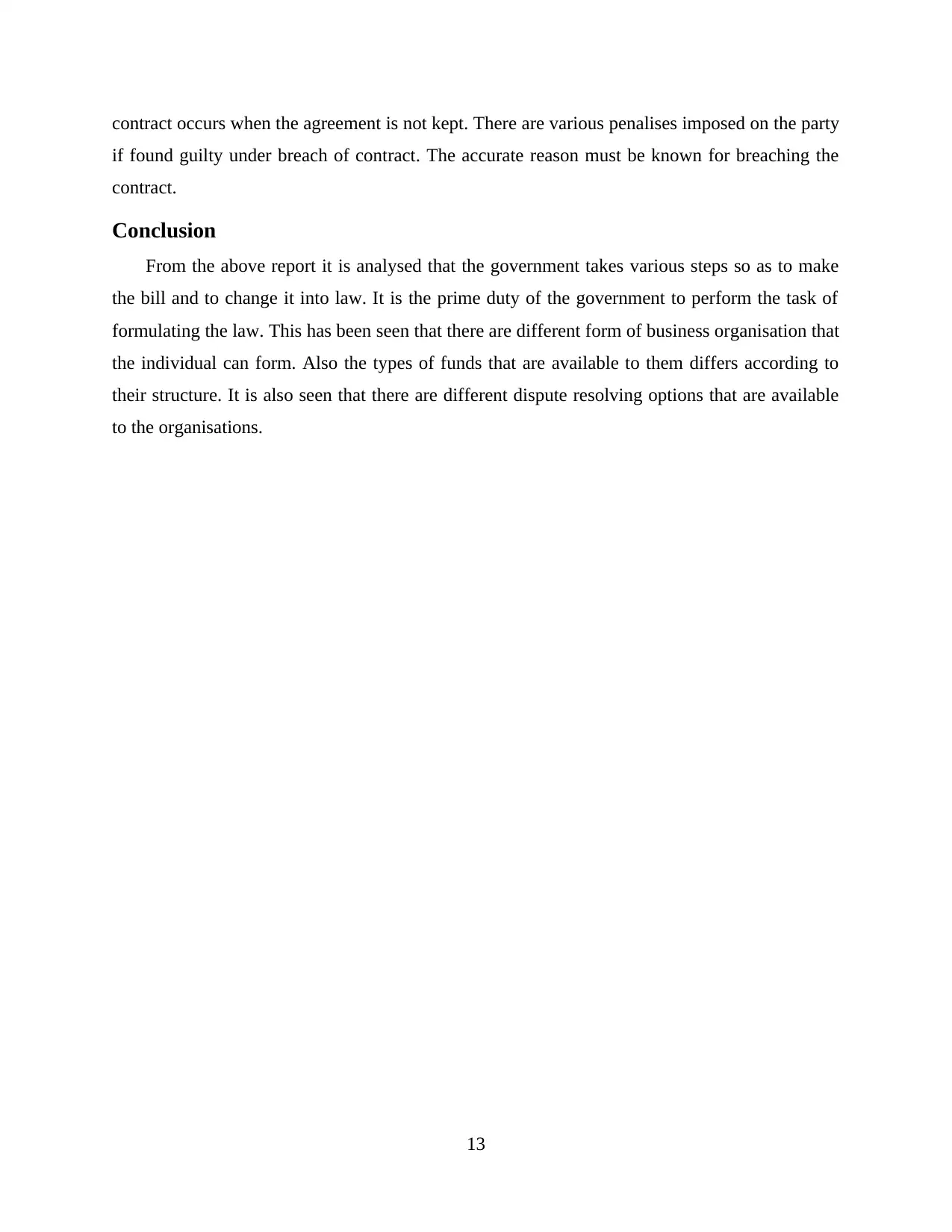
contract occurs when the agreement is not kept. There are various penalises imposed on the party
if found guilty under breach of contract. The accurate reason must be known for breaching the
contract.
Conclusion
From the above report it is analysed that the government takes various steps so as to make
the bill and to change it into law. It is the prime duty of the government to perform the task of
formulating the law. This has been seen that there are different form of business organisation that
the individual can form. Also the types of funds that are available to them differs according to
their structure. It is also seen that there are different dispute resolving options that are available
to the organisations.
13
if found guilty under breach of contract. The accurate reason must be known for breaching the
contract.
Conclusion
From the above report it is analysed that the government takes various steps so as to make
the bill and to change it into law. It is the prime duty of the government to perform the task of
formulating the law. This has been seen that there are different form of business organisation that
the individual can form. Also the types of funds that are available to them differs according to
their structure. It is also seen that there are different dispute resolving options that are available
to the organisations.
13
Paraphrase This Document
Need a fresh take? Get an instant paraphrase of this document with our AI Paraphraser
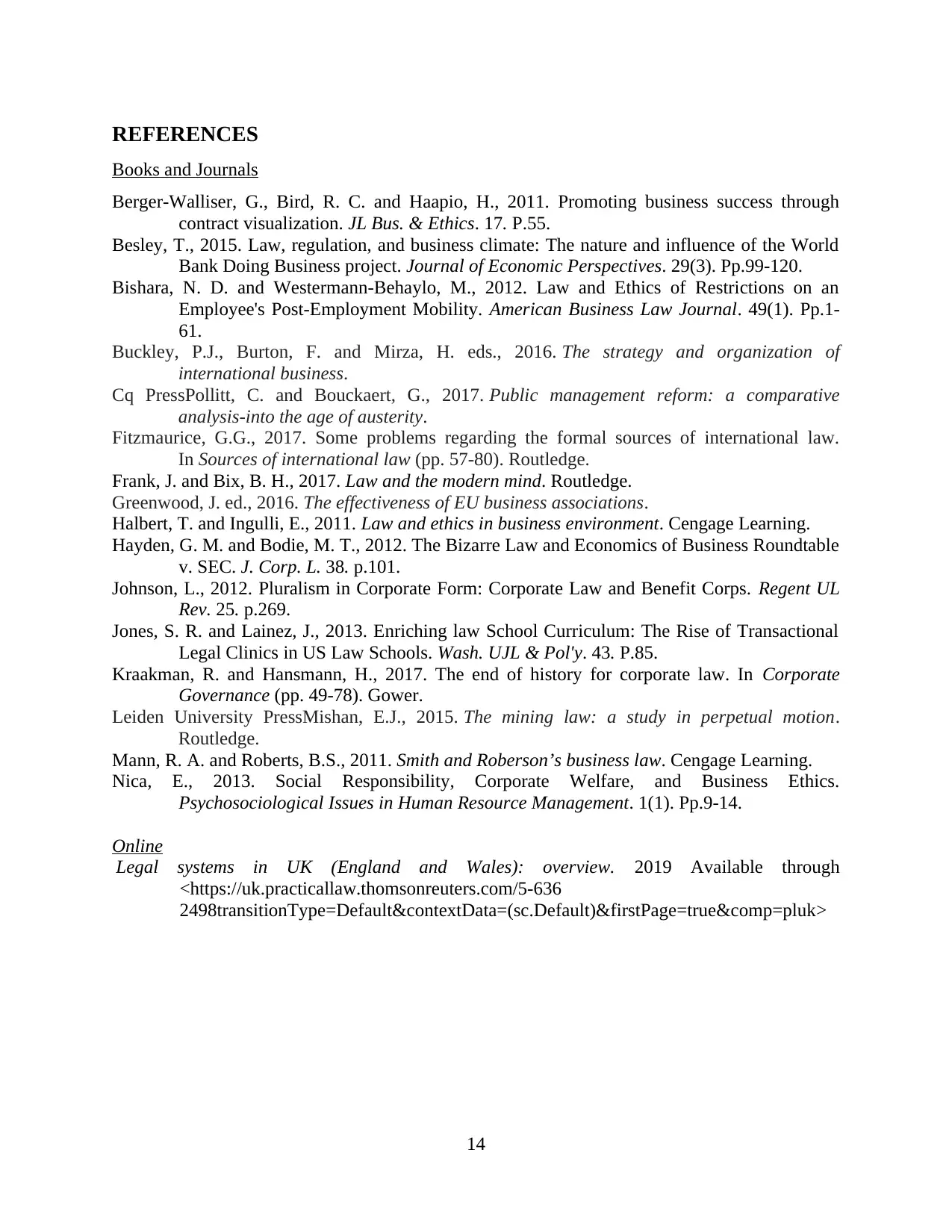
REFERENCES
Books and Journals
Berger-Walliser, G., Bird, R. C. and Haapio, H., 2011. Promoting business success through
contract visualization. JL Bus. & Ethics. 17. P.55.
Besley, T., 2015. Law, regulation, and business climate: The nature and influence of the World
Bank Doing Business project. Journal of Economic Perspectives. 29(3). Pp.99-120.
Bishara, N. D. and Westermann‐Behaylo, M., 2012. Law and Ethics of Restrictions on an
Employee's Post‐Employment Mobility. American Business Law Journal. 49(1). Pp.1-
61.
Buckley, P.J., Burton, F. and Mirza, H. eds., 2016. The strategy and organization of
international business.
Cq PressPollitt, C. and Bouckaert, G., 2017. Public management reform: a comparative
analysis-into the age of austerity.
Fitzmaurice, G.G., 2017. Some problems regarding the formal sources of international law.
In Sources of international law (pp. 57-80). Routledge.
Frank, J. and Bix, B. H., 2017. Law and the modern mind. Routledge.
Greenwood, J. ed., 2016. The effectiveness of EU business associations.
Halbert, T. and Ingulli, E., 2011. Law and ethics in business environment. Cengage Learning.
Hayden, G. M. and Bodie, M. T., 2012. The Bizarre Law and Economics of Business Roundtable
v. SEC. J. Corp. L. 38. p.101.
Johnson, L., 2012. Pluralism in Corporate Form: Corporate Law and Benefit Corps. Regent UL
Rev. 25. p.269.
Jones, S. R. and Lainez, J., 2013. Enriching law School Curriculum: The Rise of Transactional
Legal Clinics in US Law Schools. Wash. UJL & Pol'y. 43. P.85.
Kraakman, R. and Hansmann, H., 2017. The end of history for corporate law. In Corporate
Governance (pp. 49-78). Gower.
Leiden University PressMishan, E.J., 2015. The mining law: a study in perpetual motion.
Routledge.
Mann, R. A. and Roberts, B.S., 2011. Smith and Roberson’s business law. Cengage Learning.
Nica, E., 2013. Social Responsibility, Corporate Welfare, and Business Ethics.
Psychosociological Issues in Human Resource Management. 1(1). Pp.9-14.
Online
Legal systems in UK (England and Wales): overview. 2019 Available through
<https://uk.practicallaw.thomsonreuters.com/5-636
2498transitionType=Default&contextData=(sc.Default)&firstPage=true&comp=pluk>
14
Books and Journals
Berger-Walliser, G., Bird, R. C. and Haapio, H., 2011. Promoting business success through
contract visualization. JL Bus. & Ethics. 17. P.55.
Besley, T., 2015. Law, regulation, and business climate: The nature and influence of the World
Bank Doing Business project. Journal of Economic Perspectives. 29(3). Pp.99-120.
Bishara, N. D. and Westermann‐Behaylo, M., 2012. Law and Ethics of Restrictions on an
Employee's Post‐Employment Mobility. American Business Law Journal. 49(1). Pp.1-
61.
Buckley, P.J., Burton, F. and Mirza, H. eds., 2016. The strategy and organization of
international business.
Cq PressPollitt, C. and Bouckaert, G., 2017. Public management reform: a comparative
analysis-into the age of austerity.
Fitzmaurice, G.G., 2017. Some problems regarding the formal sources of international law.
In Sources of international law (pp. 57-80). Routledge.
Frank, J. and Bix, B. H., 2017. Law and the modern mind. Routledge.
Greenwood, J. ed., 2016. The effectiveness of EU business associations.
Halbert, T. and Ingulli, E., 2011. Law and ethics in business environment. Cengage Learning.
Hayden, G. M. and Bodie, M. T., 2012. The Bizarre Law and Economics of Business Roundtable
v. SEC. J. Corp. L. 38. p.101.
Johnson, L., 2012. Pluralism in Corporate Form: Corporate Law and Benefit Corps. Regent UL
Rev. 25. p.269.
Jones, S. R. and Lainez, J., 2013. Enriching law School Curriculum: The Rise of Transactional
Legal Clinics in US Law Schools. Wash. UJL & Pol'y. 43. P.85.
Kraakman, R. and Hansmann, H., 2017. The end of history for corporate law. In Corporate
Governance (pp. 49-78). Gower.
Leiden University PressMishan, E.J., 2015. The mining law: a study in perpetual motion.
Routledge.
Mann, R. A. and Roberts, B.S., 2011. Smith and Roberson’s business law. Cengage Learning.
Nica, E., 2013. Social Responsibility, Corporate Welfare, and Business Ethics.
Psychosociological Issues in Human Resource Management. 1(1). Pp.9-14.
Online
Legal systems in UK (England and Wales): overview. 2019 Available through
<https://uk.practicallaw.thomsonreuters.com/5-636
2498transitionType=Default&contextData=(sc.Default)&firstPage=true&comp=pluk>
14
1 out of 14
Related Documents
Your All-in-One AI-Powered Toolkit for Academic Success.
+13062052269
info@desklib.com
Available 24*7 on WhatsApp / Email
![[object Object]](/_next/static/media/star-bottom.7253800d.svg)
Unlock your academic potential
© 2024 | Zucol Services PVT LTD | All rights reserved.





